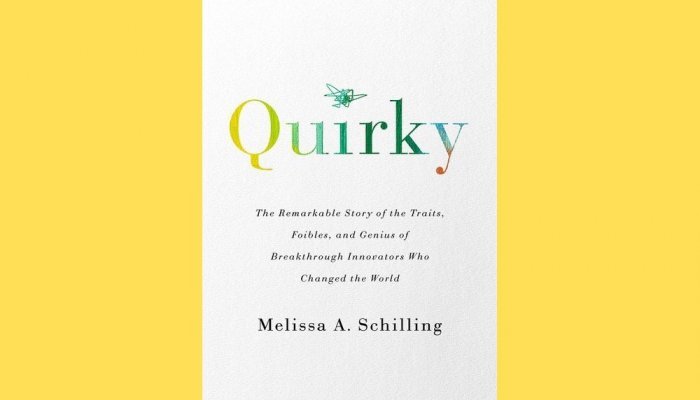These are the sorts of questions that prompted Melissa A. Schilling to write Quirky, The Remarkable Story of the Traits, Foibles, and Genius of Breakthrough Innovators Who Changed the World.
In this book, Schilling, the John Herzog Family professor of management and organisations at New York University’s Stern School of Business, explores why some people are able to create serial innovations. She delves deeply into the lives of eight creative geniuses – Albert Einstein, Benjamin Franklin, Elon Musk, Dean Kamen, Nikola Tesla, Marie Curie, Thomas Edison, and Steve Jobs – to identify the traits and experiences that led them to become breakthrough innovators.
What innovation is (and isn’t)
“I usually define innovation as the application of new ideas, methods or materials to useful purposes,” Schilling says. “There are two key parts of this definition: ‘new’ and ‘useful’. You will find almost any credible definition of innovation includes these two pieces. Note that it does not include words like ‘business’ or ‘technology’, as innovation can occur in any domain and does not have to be manifest in physical artefacts. New business models, school curricula or organisation designs are innovations just as much as new drugs, transportation devices, or software algorithms.”
Speaker, advisor, practice strategist, innovator and GIBS faculty member, Abdullah Verachia, says he finds Azim Premji’s thoughts on innovation useful (the Indian business entrepreneur who served as chairman of Wipro). “He said everyone thinks innovation is ideas,” explains Verachia. “But Premji says that's not innovation – it's an ingredient. He says creativity is thinking new things, and innovation is about applying that creativity and doing new things. It's as much action as it is ideas, with as much implementation as it is design.”
Verachia adds that while some people are great idea generators, others are better at synthesising an idea and still others at critiquing ideas or executing them. “These all play a role in the innovation pipeline,” he says.
However, Schilling says one of the most pervasive myths of innovation is the belief that it’s usually accelerated or improved through working in teams. “It just isn't this simple. A new idea must first be created in a person's mind. Sometimes that process is facilitated through interacting with others, but sometimes, interacting with others actually gets in the way. There may be other stages of innovation that more reliably benefit from group work (such as execution of an idea after it's been decided upon), but ideation itself often benefits from time spent alone, unfettered by the pressures or distractions of others. There has been a lot of work on this, and we understand pretty clearly why people need alone time to generate and elaborate their most creative ideas, and yet in organisations like businesses and schools, you will still see this blind faith put into brainstorming teams.”
Can you train for innovation?
The short answer: yes and no. In her book, Schilling notes that the people she profiled are in a league of their own that is beyond most people’s level of play. Their innovative output was, to some extent, a result of innate traits coupled with situational advantages that were unique to them. Being a serial breakthrough innovator also comes at a cost. Schilling points out that Edison and Franklin abandoned their family for long periods; Curie largely left the raising of her children to her father-in-law, and neither Tesla nor Kamen ever married or had children. This is not the life many would choose. However, Schilling does believe that these innovators’ stories yield valuable lessons for anyone wishing to promote innovation.
“There are certain traits that can facilitate a person being innovative, but they do not always do so, especially not in isolation. For example, if someone is smart and motivated to innovate, having a tendency toward non-conformity or anti-authoritarianism could be really valuable because it can help the innovator resist the tendency of groups to bring everyone to some compromise position that is well understood but not particularly breakthrough. On the other hand, non-conformity in isolation from other valuable traits may have little effect (or even negative effects) on innovation,” she says. “Similarly, intelligence can be extremely valuable to innovation, but it does not guarantee innovation because there are a lot of different paths an intelligent person can take, and many of those paths lead toward replicating or executing known solutions rather than creating better solutions.”
Each of the traits discussed in Schilling’s book has the potential to have a beneficial effect on innovation but work in combination, not in isolation. “Some of these traits are innate and give a person an innate advantage in their propensity or ability to innovate – high working memory combined with high self-efficacy and idealism, for example, is a pretty powerful combination,” she says. “However, if you didn't get these traits innately, most of them are either trainable, or there are workarounds. For example, self-efficacy and idealism are certainly trainable, and while high working memory might not be trainable per se, you can learn to become more efficient in how you use your working memory, and you can learn to use external forms of memory (e.g., making extensive use of well-organised notes, for example).”
Success in separation
Schilling tackles three main themes in her book: creativity and originality, effort and persistence, and situational advantage.
“One of the most surprising traits (to me at least) that the innovators had in common was their sense of ‘separateness’. Nearly all of them felt socially detached or as if they didn't belong to the social worlds around them. They tended to work alone and socialised very infrequently,” says Schilling. “Many were noted for being detached even from their family members. Sometimes this was because of something that happened to them (for example, when she was a child, Marie Curie became chronically depressed after her mother's death; Thomas Edison's mother pulled him out of grammar school after a teacher ridiculed him, and he was largely deaf).
For other people, ‘separateness’ seems to have been part of their innate personality. Separateness can give an innovator an advantage when it comes to working alone and generating non-conforming solutions. It also has disadvantages. For example, it can make it harder for an innovator to get the support they need or to get their ideas adopted. This again highlights that a trait doesn't usually work in isolation, and it's not always advantageous – it just has the potential to be.”
In this regard, she says Covid-19 may have had benefits for innovation, both by causing more people to work on their own (and, hopefully, becoming more comfortable working on their own, which could lead to long-term effects) and by forcing people to break with some norms that might have prevented innovation.
Fostering innovation within organisations
“There are many ways organisations can unleash the breakthrough innovation potential of their employees and even ways that parents can facilitate the breakthrough innovation of their children,” says Schilling. “One of the most powerful, in my opinion, is through helping individuals increase their self-efficacy – the sense that they can overcome all obstacles to achieve their goals. That makes people happier, more motivated, less daunted by risk, and more persistent in the face of failure. We could all benefit from more of that!”
Other strategies she suggests include challenging norms and paradigms, providing people with time alone, inspiring grand ambitions, helping people to “find the flow” (tapping into people’s intrinsic motivators), and increasing access to technological and intellectual resources.
Verachia says one of the most important characteristics of innovators is curiosity, which should extend beyond their field of work. This enables them to “connect the dots” between seemingly disparate ideas. “Can you learn curiosity? I definitely think you can spark curiosity in people,” he says. “For example, every single day at our family dinner table, I ask the question, ‘What have we learned different today?’”
Five ways to foster innovation
Verachia shares his five-point strategy for cultivating innovation within organisations:
- Seek out new experiences: We’re limited by our lived experiences. Expanding this experience by embracing new experiences can foster innovation, but it must be done intentionally.
- Develop an appetite for risk: Not unfettered risk, but rather an ability to recognise that innovation requires change, which always carries risk.
- Cultivate empathy: Innovative individuals step into the shoes of other individuals. In many cases, innovation is solving problems that are bigger than one's own.
- Focus on finding patterns: Almost every innovation is not something new – it’s a new combination of existing resources, services, or capabilities. For example, Uber took geolocation technology and coupled it with big data, with cars that are unused and people willing to work in a gig economy environment.
- Learn to collaborate: To move from a good idea to a real innovation, ideas must be executed, which usually requires buy-in and collaboration.
Three mistakes to avoid
Verachia consults to companies looking to create a culture of innovation. He suggests avoiding these common pitfalls:
- Innovation is not always addition: “Everyone thinks innovation is adding things,” he says. “The success of Steve Jobs was that he was a subtractor. He took things away. In his second Apple stint, he took the product range from 15 to three. He took away the keypad, the USB and the CD-ROM and created the iPad.”
- Don’t start with the physical space: “Often companies want to start by building an innovation lab. But putting people in a room and saying, ‘In this room you must be innovative’ goes against the very grain that innovation should not be limited to the workplace, but that you should have a mindset of innovation across all of what you do.”
- Make room for innovation: Give people time to think and help them gain exposure to teams outside of the ones they work in. Reward and incentivise innovation. “The magic of organisations is in creating the fluidity for cross-cultural exchange. You can't expect it to happen – you have to make it happen,” says Verachia.






